Cream of tartar is one of the more mysterious yet most common ingredients in baking. It can also be one of the more elusive ones to find in some countries! [EDITOR'S NOTE: I can vouch for that! One of the most commonly asked questions about my royal icing video on YouTube is: "What can I substitute for cream of tartar? I can't find it in my country."]
So let's talk about it and see if we can't bring this mystery ingredient into clearer focus . . .
Cream of Tartar and Tartaric Acid
In South Africa, cream of tartar and tartaric acid are both easily available. As their names suggest, they are closely linked. Tartaric acid is quite sour. At the beginning of the 19th century, it was used to add sharpness to soft drinks such as lemonade (google "sherbet" in its UK meaning), or to reduce oxidization in food. (Source: wikipedia). Tartaric acid is a by-product of winemaking, but these days it is synthetically produced. Cream of tartar is made by combining tartaric acid with potassium hydroxide. As such, you might also find cream of tartar listed on product labels by one of its chemical names: potassium acid tartrate, potassium hydrogen tartrate, or potassium bitartrate. This combination partially neutralizes the tartaric acid, so cream of tartar is less acidic than tartaric acid. (It also clumps less easily.) Both cream of tartar and tartaric acid most often present as fine white powder, but they can come in crystalline form in some countries.
How Cream of Tartar is Used
Most often in baking, cream of tartar is combined with sodium bicarbonate aka baking soda (and sometimes a bit of cornstarch) to make baking powder and act as a leavening agent. In cookie baking in particular, cream of tartar and baking soda are sometimes left out of the cookie recipe to prevent spreading. On the other hand, cream of tartar on its own is often included in royal icing recipes, as one of its key functions is to stabilize whipped egg whites. (It's also used to stabilize whipped cream and to prevent sugar syrups from crystallizing.) You can read a more detailed explanation about the stabilizing effect of cream of tartar on kitchensavvy.com, but in short: the acid in it prevents water from separating from an egg white foam, which would, in turn, cause the foam to collapse. Cream of tartar can be replaced with about double the amount of strained lemon juice, as it is also an acid that has a similar stabilizing effect.
 Cream of Tartar Label with Uses
Cream of Tartar Label with Uses
Cream of Tartar Around the World
South Africa: Cream of tartar is available at every supermarket as a powder. In Afrikaans, it is called kremetart. Incidentally, a baobab tree is called a kremetartboom because its fruit contains tartaric acid (and Vitamin C).
Belgium: Cream of tartar is called wijnsteenzuur, and can be found in pharmacies. When I went to ask for it, the pharmacist had to look it up, as he hadn’t heard of it. He said it could be ordered, but he didn’t know if it would come as crystals, as is the case in some countries, or powder, as is obviously desirable for baking.
Germany: Called weinstein, cream of tartar is available in pharmacies, and comes in sugar-size crystals.
United States: Here, cream of tartar is widely available on the spice shelves of nearly every supermarket, and it comes as a very fine powder. It would not occur to most consumers to look for it in a pharmacy, and it's unlikely they would find it there. McCormick is one of the more popular brands.
An Experiment
It’s time to test the influence of cream of tartar on egg whites. I could think of no better way than to bake meringues since they are all about egg whites (and sugar)! I made them in two versions: one without cream of tartar and one with. (Disclaimer here: I need more practice!)
Batch one: I beat 3 large egg whites until foamy; then I gradually added 55 grams (about 2 ounces) of icing sugar per white (for a total of 165 grams or 6 ounces). I kept beating until stiff (about 7 minutes). I made hearts with half of the mix, and set the other half aside.
Batch two: I added 3/8 teaspoon cream of tartar to 3 large egg whites and beat until foamy; then I proceeded to add the same amount of sugar, just as I did for batch one. I beat the whites to the same stiff consistency, which took two minutes less. Once again, I made hearts with half of the mix, and set the other half aside.
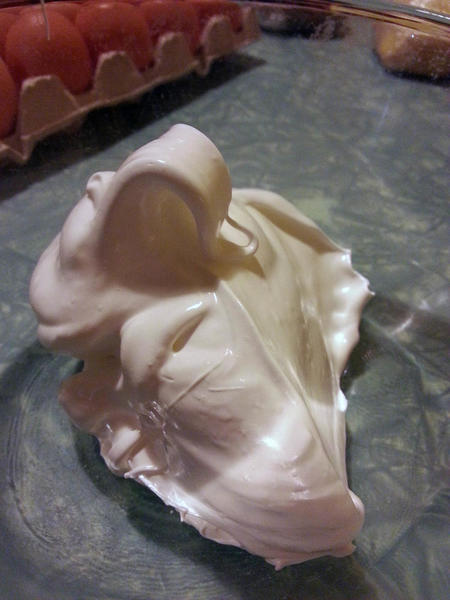
Meringue without Cream of Tartar
I baked the batch one (no cream of tartar) meringue hearts at 160 °C (320 °F) until they just started colouring brown, and promptly forgot to write down exactly how much time this took. ![]() But, I baked the batch two (cream of tartar) meringue hearts at the same time, for the same amount of time. While they seemed to be baked enough, they had not yet started to colour like the hearts from batch one.
But, I baked the batch two (cream of tartar) meringue hearts at the same time, for the same amount of time. While they seemed to be baked enough, they had not yet started to colour like the hearts from batch one.
However, the big difference between the two batches of meringues became apparent after they came out of the oven. Most of the batch one (no cream of tartar) meringues collapsed and cracked, whereas the batch two (cream of tartar) meringues held together much better, and only two of them cracked.
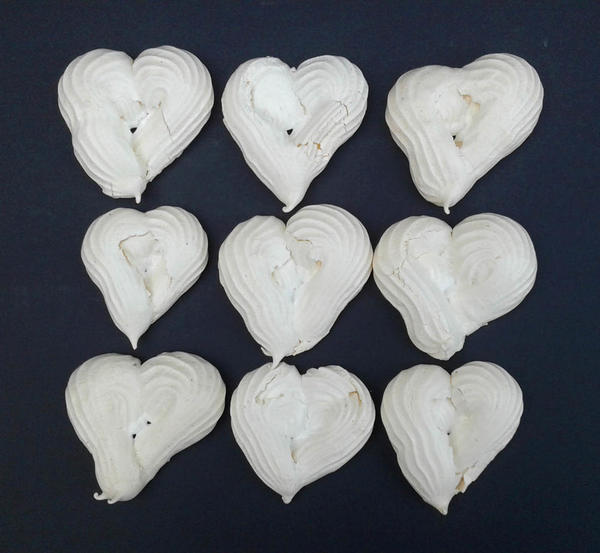 Baked Meringues without Cream of Tartar
Baked Meringues without Cream of Tartar
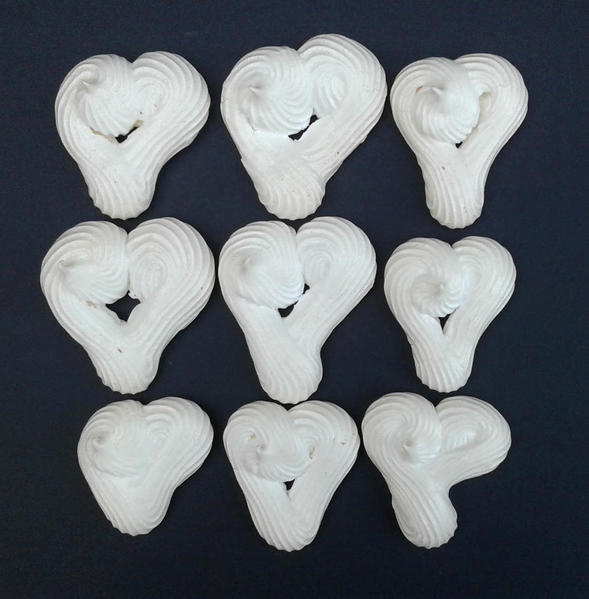 Baked Meringues with Cream of Tartar
Baked Meringues with Cream of Tartar
Remember the beaten meringue mixes that I set aside? Well, I let both sit on the counter for 20 hours (just for good measure, to make sure that I was seeing a real difference and not a perceived one). Both mixes lost some of their stiffness and "sagged" a bit. But the difference was that the batch one (no cream of tartar) mix separated, and liquid pooled along the edges. (I wasn’t brave enough to test if it was egg white or water!)
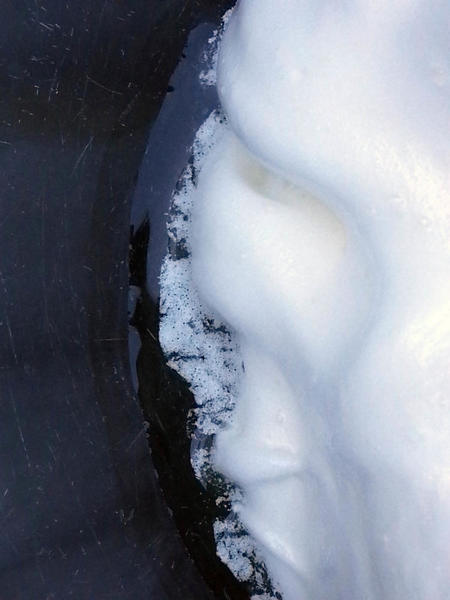
Meringue Mixture without Cream of Tartar, After 20 Hours
Batch two held together much better, with only some small air bubbles forming along the edges.

Meringue Mixture with Cream of Tartar, After 20 Hours
This experiment clearly illustrates how cream of tartar helps to keep whipped egg whites together. To translate this to royal icing, one could assume that royal icing with cream of tartar would also separate less between decorating sessions. I wonder if cream of tartar would have any influence on air bubbles rising to the surface of the icing on a decorated cookie, or if those bubbles would instead remain trapped within the icing?
Other questions that could be answered with additional experiments:
Does cream of tartar influence the volume of beaten egg whites? Does the amount of added cream of tartar affect egg foam stability? Does the acid in cream of tartar affect colors? (One would anticipate that the acid would change the color of most natural food colourings that are anthocyanin-based.) Does royal icing with cream of tartar stay whiter longer, as some have reported? And does colouring set more stably with less bleeding when cream of tartar is used? [EDITOR'S NOTE: If anyone's game to test, go for it, and please report back to us here! I can safely say that cream of tartar does change the color of pH-sensitive natural food colorings.]
As a last note: please let us know in the comments what cream of tartar is called in your country, where it is available, and in what form. Thanks!
Sources: wikipedia, kitchensavvy.com, thekitchn.com, mccormick.com, and other websites and blogs.


Liesbet Schietecatte, born in Belgium but permanently living in South Africa since 2005, accidentally found her way into cookie decorating in 2012. Grabbing moments in between her career as an archaeologist and being a mommy and a wife, Liesbet bakes Belgian biscuits like speculoos in the tradition of her grandmother’s family who were bakers for several generations, but she gets the most creative satisfaction from decorating with royal icing. She bakes and decorates for occasional orders and at times for a crafters' market, but mostly for the enjoyment and challenge of trying out new things. To honour her family's baking legacy, Liesbet uses the family name to give a home to her baking pictures on Facebook: Stock’s – Belgian Artisan Bakes.
Photo credit: Liesbet Schietecatte
Note: Toolbox Talk is a bimonthly Cookie Connection blog feature written by Liesbet Schietecatte that explores similarities and differences in cookie tools and ingredients from all over the world. Its content expresses the views of the author and not necessarily those of this site, its owners, its administrators, or its employees. Catch up on all of Liesbet's past Cookie Connection posts here.


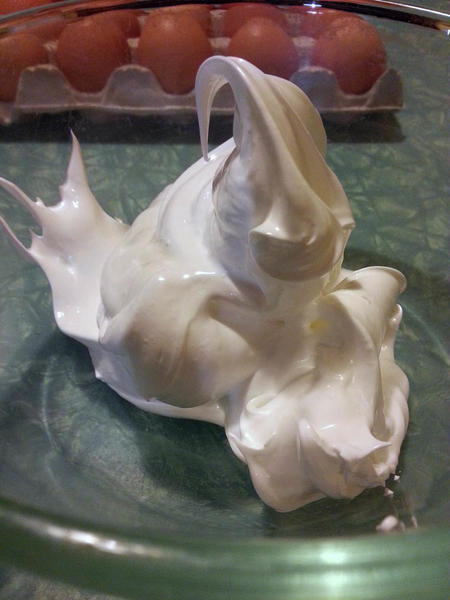

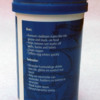


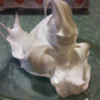
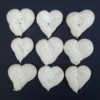
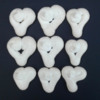


Comments (16)